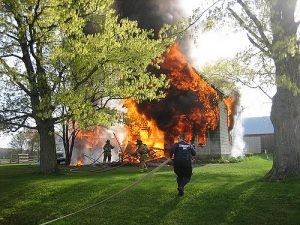
House fires can turn from a small flame into a burning inferno in less than 30 seconds. As with many things, prevention is key when it comes to reducing the risk of fire in rental properties and family homes alike. It’s of the utmost importance for landlords and property managers to be aware of legislation regarding fire safety in rental properties, so let’s look at the law and some steps you can take to protect your investment.
Smoke Alarms
At the forefront of your mission to prevent fires should be smoke alarms and heat sensors. Not only are they the best way to warn residents of a potential fire in their home (hopefully they’re just burning the toast), but it’s also illegal not to have working smoke alarms installed in rental properties.
All new smoke alarms need to meet international standards and be either hard-wired or have a battery life of eight years or more. They should be photoelectric and need to be installed as per the manufacturer’s instructions. It’s up to landlords to ensure smoke alarms are in working order and are working at the start of every new tenancy.
There are responsibilities for tenants too. They mustn’t disconnect, damage or remove smoke alarms; and they can’t replace dead batteries in older-style smoke alarms during their tenancy. Keep these points in mind during your inspections and make checking smoke alarms a priority during your visits.
To learn more about what’s required of you, read the new requirements for smoke alarms in residential rental properties, which came into effect in July 2016.
Chimney maintenance
If your rental property has a wood burner fireplace it’s essential to maintain the flue to lessen the chance of a chimney fire. Failing to do so can result in build-up of debris, soot, ash and creosote – a pungent oily liquid by-product of wood burning that can cause carcinogenic smoke – all of which increase fire danger.
Neglected chimneys account for more than 25% of all house fire claims received by FMG – over $4.5m worth over the last five years. An annual chimney sweep is often a condition in many insurance contracts, so check yours and shop around for a sweeping quote.
Cooking fires and drinking and frying
One in four house fires in New Zealand start in the kitchen, and alcohol is involved in half of all fatal fires. As a landlord it’s advantageous to speak openly with tenants about this fire risk and the steps they can take to stay safe. Cleaning stovetops helps prevent the build-up of burnt foods and spilled fats, the perfect fuel for fat fires. You can help reduce the risks by cleaning rangehood filters during your inspections and equipping residents with the right type of fire extinguisher for the kitchen and an easily accessible fire blanket. Take it a step further by making sure they know how to use them.
Appliances and wall sockets
Every electrical appliance in your investment property carries a fire safety risk of some kind. This is a tricky one to educate tenants about, but at the very least you can keep an eye out for no-nos during your inspections.
Appliances should be turned off when not in use and unplugged from the wall, if practical. Heaters, fans and televisions should only be used in areas with adequate airflow to avoid overheating. Multi-boards should not be overloaded with too many appliances and care should be taken not to place furniture on top of extension leads.
Escape Plan
While an escape plan isn’t something you’ll have much influence over as a landlord, discussing it with your tenants will show them you care for their safety and you may cover something they didn’t consider, like the fastest route out of the house that avoids the kitchen. You can help your tenants stay safe by suggesting they keep keys in deadlocks at all times when they’re home, and that they identify the exits for every room using Fire and Emergency New Zealand’s Escape Planner and Escape Planner Experience.
Remember, reducing the risk of fire in your rental property will help you keep your residents safe, protect your asset and meet your insurance policy requirements. If you need a reality check, watch the alarming interactive video below.
https://www.youtube.com/watch?v=puy6IUd4IQ0
Image:
‘House Fire’ by Scott Teresi under CC BY-SA 2.0
